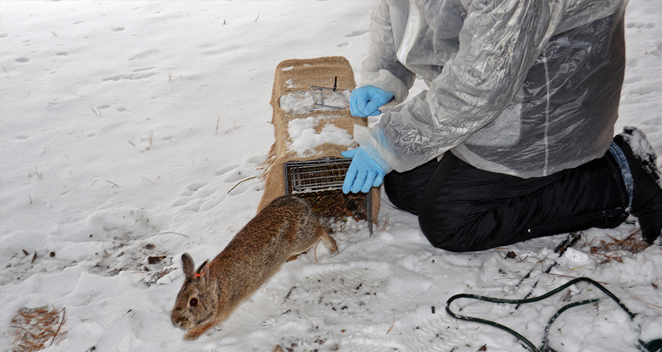Pet rabbits dont have this luxury so owners must make sure their rabbits have permanent access to a sleeping area that is kept constantly sufficiently warm dry and draught free. As we know during the summer months the temperatures can climb to anywhere between 50 to 85 degrees Fahrenheit.
 Caring For Your Rabbits In Cold Weather
Caring For Your Rabbits In Cold Weather
Rabbits are more able to cope with cold weather conditions than hot conditions but given the wrong conditions rabbits can suffer from exposure frostbite and decreased body temperature.

Can bunnies survive in cold weather. Thus wild rabbits are very well equipped to survive in the extreme cold temperatures. There are several considerations for rabbit owners when planning ahead for optimal care of their rabbits as the days get shorter precipitation increases and temperatures plunge. With a wind break and a good dry nest newborn bunnies survive temperatures as low as-20 degrees Fahrenheit without any supplemental heat.
Rabbits sweat through their ears and thats their only way to regulate their body temperature in the summer so you need to make sure you provide plenty of. The ideal temperature for rabbits is from about 60-70F 15-20C but rabbits can be comfortable in temperatures ranging from around 40-75F. Rabbits survive in the wild further north than most other animals but your pet rabbit relies on you to give it the advantages that allow its wild cousins to live throughout the year.
In fact cold weather often increases the energy level of domestic rabbits and invigorates them. Rabbits are most active in the winter and seek for food source during the dawn and. Despite their frail appearance rabbits are quite hardy when it comes to dealing with cold weather.
Outdoor rabbits in cold weather. But check that their living area is not in a draught and if temperatures drop very low during the night you could give them a Snugglesafe Heatpad its like a pet-safe hot water bottle for some warmth. Smaller breeds of rabbits may be more susceptible to cold temperatures than larger breeds of rabbits.
The best temperature for rabbits is between 10 to 21 degrees celsius. They do not hibernate during the winter. Although they may look small and fragile rabbits are surprisingly well-adapted to cold temperatures.
A rabbit would always rather be chilly than too hot. When it is cold rabbits will eat tree bark tree needles twigs and other wood sources to survive. In the wild rabbits live in burrows underground usually in groups to keep themselves warm.
Even though your pet rabbits are pretty hardy critters and can withstand a fair amount of heat if those temperatures become too high your bunnys life may be at risk. Hutches give security and provide insulation from harsh weather. They have the capability of surviving in below zero degrees.
The average body temperature of a healthy rabbit is between 101-103 degrees Fahrenheit. They do not hibernate during the winter. With proper care however you can ensure that your rabbit will remain healthy through the cold weather.
But check that their living area is not in a draught and if temperatures drop very low during the night you could give them a Snugglesafe Heatpad its like a. Check your rabbits body temperature regularly. It protects rabbits from adverse weather conditions like the winter cold and summer heat.
Indoor house rabbits should be fine in the cold weather as the temperature indoors tends to be regulated for yourselves. Any colder or hotter and your bun might struggle. From my personal experience bunnies can be born outdoors and survive in a nest in during a windy negative 10-degree blizzard.
It is important rabbit owners do whatever they can to ensure their pets are safe and warm during cold weather snaps as domesticated rabbits are not as efficient at keeping themselves warm as their wild counterparts. It turns out that ideal rabbit. How Cold can Baby Bunnies Tolerate.
However a heatwave could push those temperatures even higher. Rabbits are designed to not only survive but thrive in cold weather. Furthermore rabbit hutches keep predators at bay.
Wild rabbits generally do not hibernate in the winter but they do seek refuge from the cold weather. Rabbits will search for closed-in spaces. Wild rabbits are also better equipped to deal with lower temperatures due to having.
As long as she has been outside all along and slowly has been getting used to the decrease in temperatures by getting a thicker haircoat she should be fine. Has she been outside up until now. Indoor house rabbits should be fine in the cold weather as the temperature indoors tends to be regulated for yourselves.
Rabbits also have a keen sense of smell meaning they can find fruit berries and other food sources that have fallen into snow or ice. This can be sustained in outdoor temperatures of 32 degrees Fahrenheit and even slightly lower. Rabbits are known for their low body-temperature tolerance.
For rabbits that are used to the cold they can still do okay in temperatures down to about 15F as long as they are kept dry and out of the wind. Many rabbits are at their most playful during the winter months of the year. In the wild rabbits live in underground warrens where the temperature does not vary much around 10C between winter and summer.
Bunnies can get along in cold weather as long as they are acclimated to it. Cold weather can be deadly for any animal but with just a few precautions and a rabbits naturally well-insulated body the animal can live warm and comfortable in even the coldest climates. However they can survive in leaky hutches that frustrate the insulation process that their furry bodies facilitate.
With appropriate husbandry a healthy adult rabbit can be comfortable in temperatures down to 40 degrees Fahrenheit and can tolerate temperatures that are even lower if necessary. Other thigs you can do to help her would be to have a place that she can get inside out of the. The bunnies were in a wire cage snuggled in a warm nest with only a tin roof above them.